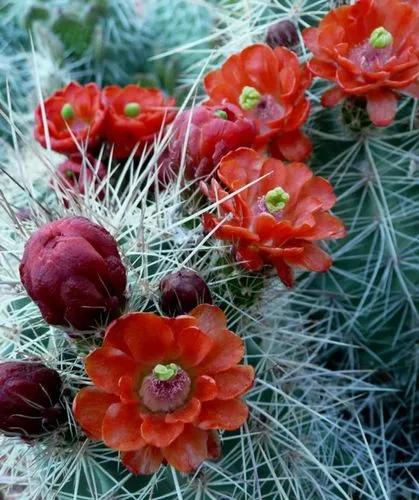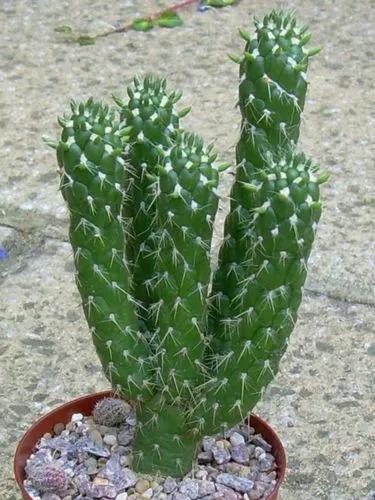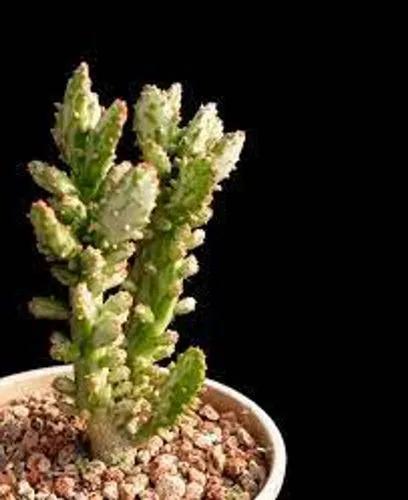Introduce yourself to the memorable beauty of the Indian Corn Cob succulent plant. With its striking resemblance to an actual corn cob, this prickly shrublet would add a glimpse of elegance to any terrarium.
Indian Corn Cob Care
Euphorbia Mammillari



Commonly known as Indian Corn Cob, Corncob Cactus, Corncob Euphorbia, and Corn Cob Plant, Euphorbia mammillaris is a fast-growing succulent species of the Euphorbiaceae family. Native to South Africa, this cacti member is a drought-tolerant plant and can grow up to 1 foot (30 cm) in height. This Cactus has a bushy growing manner, and forms stems with 7-17 ribs per each. The stems resemble corn cobs and can turn rosy pink in colder weather. The stalks are covered with pinkish-white, thick, and pointy spikes. The blooming period for the Corncob Cactus lasts from late winter to early summer. The plant produces clusters of distinctive small red and orange flowers from each stem.
How to Care for the Plant

Water

Give this prickly greenie once-a-week drink in summer and reduce hydration to once every two weeks in winter. It’s recommended to let the soil dry out completely between hydrations to avoid overwatering issues.

Pruning

It’s not necessary to prune Corn Cob Plant, as this Cactus doesn’t grow tall. However, you can practice it to maintain the plant’s shape and propagate it. The best time for cutting is early spring before the Cactus starts growing actively.

Fertilizer

Corn Cob Plant doesn’t require extra feeding. Once-a-year replanting into a fresh soil mix would be enough for this Cactus.

Sunlight

As a sun-loving plant, Corncob Cactus would benefit from 4-8 hours of direct sunlight exposure daily. Put this Cactus near a south- or west-facing window to create a close to its natural habitat environment.

Soil

Just like most cacti, Corncob Euphorbia feels best in well-draining, nutrient-poor soil. Plant this Cactus in a succulent-special potting mix with 6-8 pH. Alternatively, mix some sand and perlite with a regular soil mix to improve drainage.

Propagation

Stem cutting is the easiest way to propagate Indian Corn Cob, as this greenie grows in a bushy manner. Cut the stem at the base with a sterile blade and leave the cutting for a few days to let the callus emerge. Place the new plant in a well-draining potting mix and keep the ground consistently moist to let the cutting enroot.

Temperature

A warm climate of 64-75°F (18-24°C) would be the most comfortable for this plant. Keep it away from droughts, air vents, and heaters so as not to put the plant under stress.

Container

As with most succulent plants, the root system of Indian Corn Cob Cactus is not big, so a slightly bigger pot than the plant’s root ball would be more than enough. It’s recommended to choose a container made of porous materials such as terra cotta or unglazed clay to allow proper root aeration.

Fun fact

The plant’s common name Corn Cob Cactus hasn’t originated out of nowhere. The Cactus grows in a bushy manner and produces cylindrical stems with pinkish tips. Such a form and color combination closely resembles corn cobs.

Popularity

823 people already have this plant 46 people have added this plant to their wishlists

Common pests

Mealybugs and scale insects tend to affect Corncob Euphorbia the most often. If you spot any signs of pests, like webbing or damaged stems, treat the Cactus with insecticide.

Frequent diseases

Corn Cob Plant can fall victim to Corking and fungal infections. In case you spot sudden wilting or discoloration, treat the plant with a fungicide from a local garden store.

Botanist’s tips

Discover more plants with the list below
Popular articles






